It’s been more than a year since most companies embraced remote work, and teams are still figuring out the best tools and apps to work from home.
Remember when you were at the office, and you had everything set up? Your desk with the necessary equipment, the meeting room where you all discuss projects and progress across the hall, the coffee area where you took your breaks, talked to Stephen, etc. Everything had an order and a structure. You knew your place. But suddenly, the pandemic took over and changed everything.
Adapting to this new digital workplace was not easy, and it’s still not. However, the good news is that there are apps that make working from home a great experience. You still get to have great meetings, talk with Stephen, and have the necessary results if you implement the right strategies and tools to work from home.
Best Tools and Apps to Work from home
What tools can be used to communicate while working remotely? Or to share files and documents? What are the best remote access tools? And the list of questions goes on and on! Working from home has its ups and downs, especially when you don’t know what tools and apps to use.
A project management tool is a must, but without a collaboration tool, how will teams sync? How will they know how a project is progressing or what is the direction of that project?
You need to have all the essential areas aligned with the necessary tools. Here are the best 14 tools and apps to work from home divided into 7 categories:
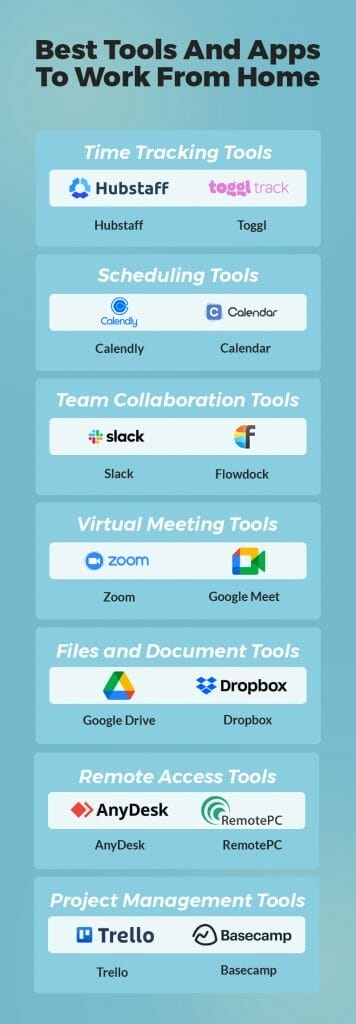
1. Time Tracking Tools
Hubstaff

Hubstaff is one of the most popular time tracking tools in remote teams. It allows you to monitor projects, employee activities, take screenshots and track activity levels during working hours.
How does it work?
Hubstaff enables you to track time through its desktop app. Employees choose when they want to start recording their time, and when this happens, it monitors what each member is doing and their screen activity. You can also track how much time you are spending on a task or a project.
Hubstaff Pros and ConsPros Cons Includes invoicing features It might create stress and pressure on the staff You can manage your tasks more efficiently Limited payroll integrations It creates reports based on activity It’s expensive
Toggl

Toggl is a time management application for remote teams. It’s a great tool to track working hours in real-time, encouraging you and your team to stay focused and avoid distractions. It provides time-tracking data that can be used to bill clients, improve performance, or change work processes.
How does it work?
Toggl allows you to track all your team’s tasks and activities. When you start working, you start the timer, and even if you forget, the application reminds you to start it or stop it when it detects idle time. It converts the tracked numbers into reports to see the summary of the time spent on different activities.
Toggl Pros and ConsPros Cons Easy to use It doesn’t include invoice features Notices inactivity and automatically stops the tracker No website blocking Integrates with different applications Doesn’t provide an in-depth report
Pricing:
- Free plan: Up to 5 users
- Starter: $10/month per user
- Premium: $20/month per user
- Enterprise: Custom printing
2. Scheduling Tools
Calendly
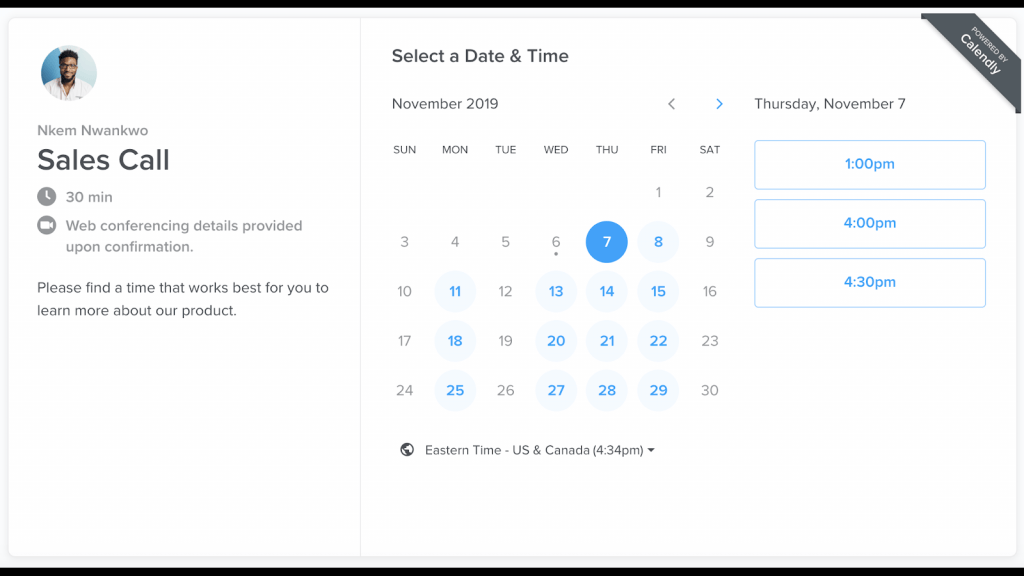
Calendly is an app perfect for scheduling meetings and events. Instead of sending back-and-forth emails to set up a date, the application shows you the person’s calendar and availability. Rather than email chains or phone messages, you can send your Calendly link (even for those without the app) and schedule appointments successfully.
How does it work?
You can sync up with other platforms such as Gmail, and every time someone wants to set up a call with you, they’ll be able to see what days and hours you have available. It also eliminates time zone confusion and saves time by eliminating unnecessary strings of conversations to set up a meeting date.
Calendly Pros and ConsPros Cons Easy to use Not mobile-friendly Integrates with various calendars Slow customer support Notification reminders Minor syncing issues with non-G Suite products
Pricing:
- Basic: $0
- Premium: $10/month per user
- Pro: $15/month per user
- Enterprise: Custom pricing
10to8

A simple and professional scheduling software. It consists of a booking system that schedules and runs virtual appointments smoothly. As it is integrated with Zoom and Microsoft teams, users can conduct different types of appointments. They can book and organize meetings easily without wasting time. You can also track attendance, report on non-shows, and get data on staff performance.
How does it work?
As 10to8 is cloud-based, it allows users with a customized booking website where clients can schedule appointments, pay for events or services, and access existing bookings. They can schedule, cancel, or reschedule meetings.
10to8 Pros and ConsPros Cons Great customer service Difficult set-up Easy to use booking system It doesn’t have a mobile app Great price No invoice capabilities
Pricing:
- Small business: Free (2 staff loggins)
- Basic: $9.6/month (2 staff loggins)
- Grow: $20/month (3 staff loggins)
- Bigger business: $40/month (6 staff loggins)
- Enterprise: custom pricing
3. Team Collaboration Tools
Slack

Slack is an instant messaging app for businesses that connects people to the information they need. It’s one of the most popular tools among remote workers, and it has transformed the way organizations communicate.
How does it work?
Slack allows you to message your colleagues in real-time or asynchronously. It consists essentially of a chat room for the entire company, and it replaces emailing for more direct and easy communication. You can organize communications by creating different channels; it allows private messaging and sharing files and information. Another great feature is that it integrates with different apps to manage everything through one single platform.
Slack Pros and ConsPros Cons Highly customizable Conversations get deleted after 14 days Rich set of tools Low audio and video quality Integrates with different applications Minimum file storage
Pricing:
- Free
- Pro: $6.67/month per user
- Business: $12.50/month per user
- Enterprise: Custom pricing
Flowdock
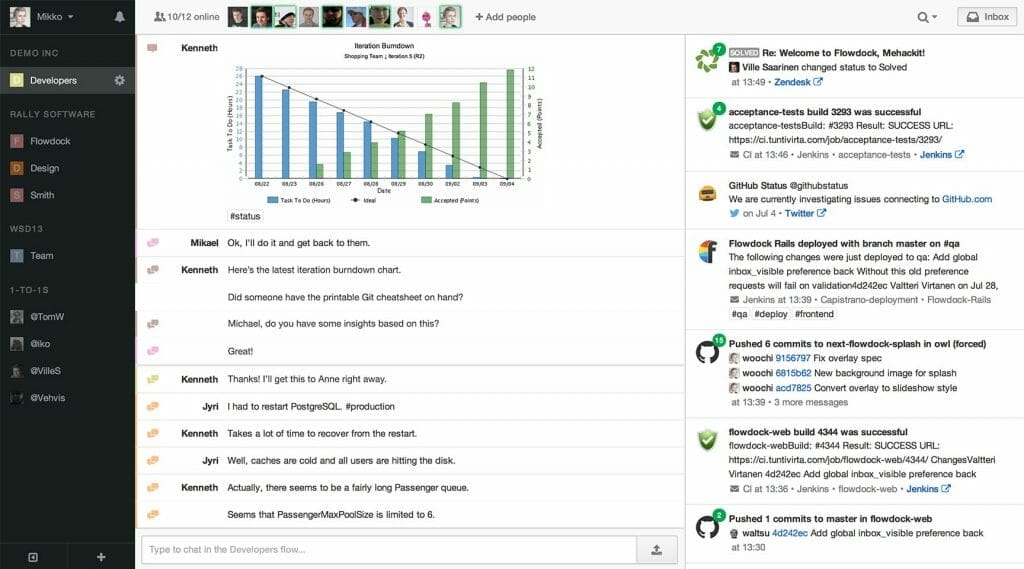
Flowdock is a great tool for remote teams to boost collaboration. It enables various functions such as inbox and chat for teams to use daily. It has more than 35 integrations, and it allows companies to get insights into the communication patterns and make the most out of teams to increase productivity.
How does it work?
Flowdock integrates conversations, emails, feeds, alerts, and notifications all in a single dashboard. You have easy access to find the people you need to talk with or to find/share information quickly.
Flowdock Pros and Cons Pros Cons Multiple integrations Poor mobile app experience Intuitive threading system No native video chat available Organized team communication Lack of multi-individual direct messages
Pricing:
- Free version
- Pro: $3/month per user
- Enterprise: $9/month per user
4. Virtual Meeting Tools
Zoom

Zoom has become the most popular video-conferencing application; it has reached, counting both free and paying users, a total of 300 million daily meeting participants. This is one of the must-have applications to work from home as it allows you to connect visually and audibly with your team.
How does it work?
Zoom works as a video conferencing tool where you can conduct your daily meetings or even webinars with up to 1,000 video participants and 10,000 viewers. This application is optimized to work reliably, it has great sound and video options, and the best part is that it’s easy to use. You also have the option to record meetings or even to use an instant video chat option.
Zoom Pros and ConsPros Cons Supports large audiences Limited meeting controls Scalable for small, medium, and large businesses Requires strong internet connection to work efficiently Easy to use Weak security system
Pricing
- Basic: Free
- Pro: $149.90/annually for small teams
- Business: $199.90/annually for small/medium teams
- Enterprise: $240/annually for big businesses
Google Meet

Google Meet, formerly known as Google Hangouts, is a video-call software that allows people to speak or share video with each other from anywhere with internet access. This tool is particularly designed for businesses and organizations that work remotely.
How does it work?
All you need to use Google Meet is to have a Google Account. You can create online meetings for up to 100 participants for 60 minutes. It also has advanced features for organizations that include meetings with 250 participants or live streaming with up to 100,000 viewers.
Google Meet Pros and ConsPros Cons Compatible across devices Limited features Unlimited number of meetings You can’t record meetings Adjustable layouts and screen settings It doesn’t have the best video-audio quality
Pricing:
- Google Meet: Free
- Google Workspace Essentials: $8/month per user
- Google Workspace Enterprise: Custom pricing
5. Files and Document Tools
Google Drive

Google Drive is a file storage and synchronization service that allows users to store files in the cloud easily. They can store and share files across multiple devices and users. It’s built on collaborative tools and built-in integrations, making it a must-have tool to work from home.
How does it work?
Google Drive is basically the digital version of a hard drive. You only need to have a Google account to use it, and it gives your access to upload and save a range of different files such as documents, videos, photos, and audios on the cloud. Remote teams can use this tool for documentation and save and organize important information as it gives you access to the files from any location and any device.
Google Drive Pros and ConsPros Cons Compatibility with files of various extensions Internet connection is required Accessibility You need to pay for extra space Secure platform Slow uploading speed
Pricing:
- 15GB: Free
- 100GB: $1.99/month per user
- 200GB: $2.99/month per user
- 2TB: $9.99/month per user
Dropbox

Dropbox is a cloud storage app with the purpose of helping teams to share files and folders easily. It provides powerful sharing features as well as collaboration options, making it a great asset for remote teams.
How does it work?
After subscribing to Dropbox, you can use its storage space known as the cloud. Dropbox works like a folder that stores all your essential files, allowing you to access them from any device anywhere in the world.
Dropbox Pros and ConsPros Cons User-friendly interface Limited search function Data integrity No real-time editing Fast syncing Limited storage
Pricing:
- Basic: Free
- Plus: $9.99/month per user
- Family: $16.99/month – maximum of 6 users
6. Remote Access Tools
AnyDesk

AnyDesk is a free remote access program that supports unattended access and allows you to transfer files. AnyDesk enables you to connect to a computer remotely regardless of your geographical location.
How does it work?
AnyDesk can be downloaded on many platforms. This application aims to enable access to help organizations check and solve issues in different computers. Users that want to access their computers at home when they are traveling can do it with the AnyDesk app.
AnyDesk Pros and ConsPros Cons Light and safe Difficulties when sharing large files Compatible with different devices Mobile version is poor Great customer service It doesn’t allow to have multiple displays
Pricing:
- Essentials: $9.99/month per user
- Performance: $19.99/month – allows 3 devices
- Enterprise: Custom pricing
RemotePC

RemotePC is a secure remote access solution that allows organizations to access and control their computer remotely from any device.
How does it work?
It works with any device (iOS/Android), and it allows you to connect your remote computers to work from home or anywhere you choose. It provides remote access directly via the web, no software installation is required.
RemotePC Pros and ConsPros Cons Multiple monitor access Expensive Real-time chat Lack of enterprise integrations Collaboration tools Speed problems
Pricing:
- Consumer: $22.12/yearly
- Soho: $52.12/yearly
- Team: $187.12/yearly
- Enterprise: $374.62/yearly
7. Project Management Tools
Trello
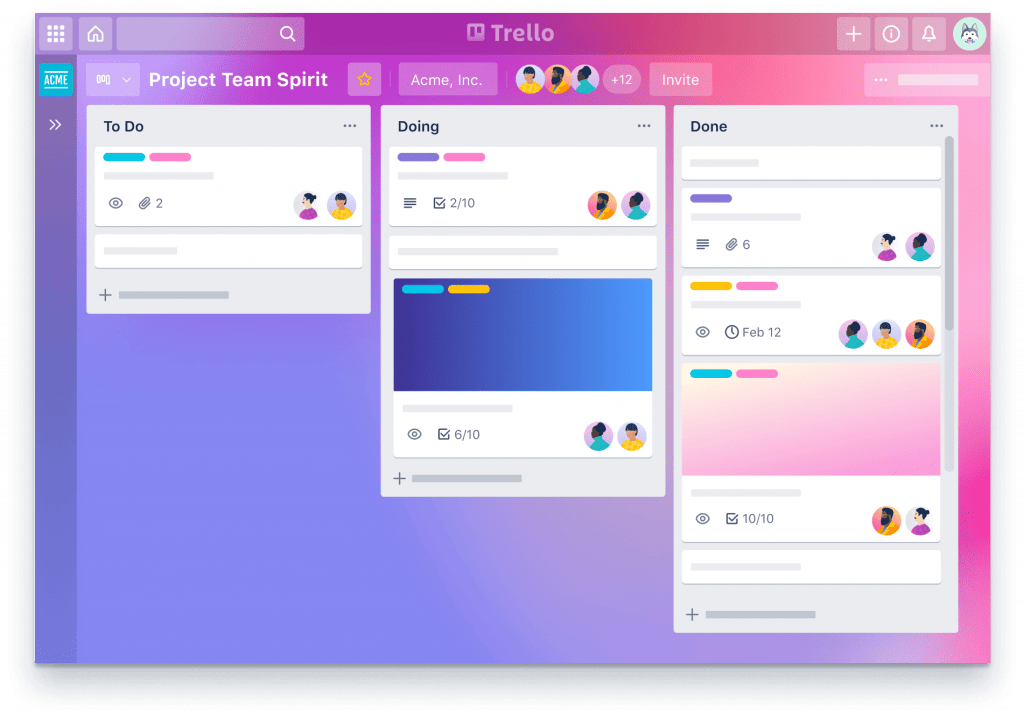
One of the best project management tools for remote teams is Trello. It consists of a collaboration tool that organizes all of your team’s projects into boards. The key characteristic of Trello is that at one glance, you’re able to know how a project is moving forward: what’s being worked on, who’s working on what, and what’s on hold.
How does it work?
Trello users organize projects using the Kanban board format. You are able to streamline your project workflow by creating custom lists, tasks, adding members, due dates, etc. You can also upload files and comments.
Trello Pros and ConsPros Cons Fast real-time updates Suitable mostly for small projects/teams You can see an entire project in just one glance Limited storage Easy to use Limited customization features
Pricing:
- Free
- Business Class: $10/month per user
- Enterprise: Custom pricing
Basecamp
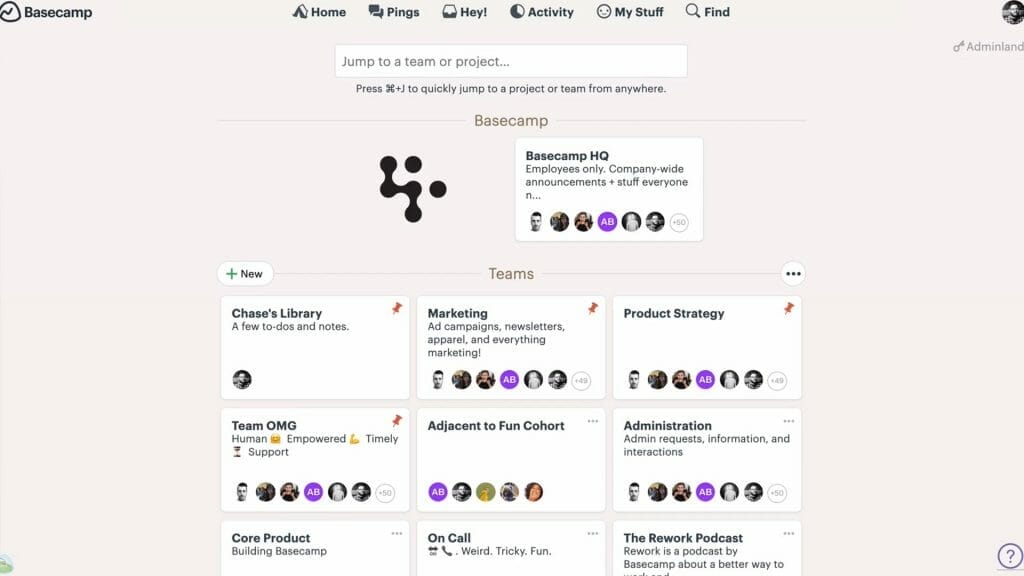
Think of Basecamp as the ultimate remote team collaboration package. You have all in one application: from projects to message boards, calendars, to-dos, all in one place. It’s one of the best project management apps for remote teams.
How does it work?
You can access Basecamp either by phone or web, and it gives you the necessary tools to keep track of projects. You can set up to-dos, due dates, a schedule, upload files, and have message boards.
Basecamp Pros and ConsPros Cons Built-in communication features Limited customizations Great customer support Poor chat management Integrations and cross-device features High learning curve
Pricing:
- Basecamp Personal: Free
- Basecamp Business: $99/month – unlimited users
Get Ready for Productive Remote Working
Building and managing a remote team can be intimidating at first. But the truth be told, it’s all about having the right tools and apps to work from home. With these tools, you can improve communication, project management, time tracking, and basically every aspect that makes teams (any type of team, both remote and onsite) succeed.






